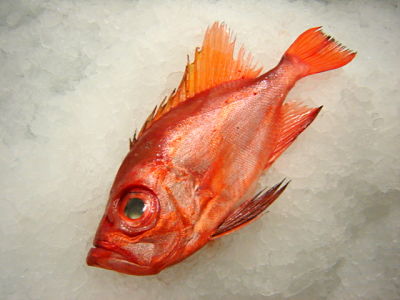

Bigeye is one of the unconventional fish gaining in popularity. Photo: Total Catch Market
In a recent issue of Audubon, journalist Dan Oko wrote about “trash fish” coming to the table:
In a Houston industrial park about 50 miles from the Gulf of Mexico, fishmonger P.J. Stoops sells an array of unusual species. Instead of such popular seafood as shrimp and red snapper, the shop, Total Catch Market, specializes in the “trash fish” Gulf Coast commercial fishermen catch inadvertently. The offerings have inspired Houston chefs and at-home cooks to experiment with lesser-known species, from the tunalike Almaco jack to the Pixar-worthy bigeye. On a typical Saturday, Stoops sells out of up to 300 pounds of fish by 10:30 a.m.
Although bycatch remains a dirty word for many conservationists, reflecting waste in the industry, Stoops is part of a national movement looking to shift American attitudes about seafood. Expanding people’s palates to include sometimes strange-looking fish caught in local waters promotes more sustainable fisheries. Without Total Catch Market, dozens of captains would instead dump the bycatch overboard. “We have the second most productive fishery on the planet,” Stoops says of the Gulf. “The point is to approach it rationally.”
Beth Lowell, campaign director for environmental group Oceana, doesn’t object in principle to selling these fish. “For the most part,” she says, “the fish are already dead. So it doesn’t make sense to dump them overboard.” Enormous trawl nets can unintentionally scoop up nontarget fish, birds, and other sea life; Oceana and other groups advocate counting each animal caught, and setting catch caps for each of those species.
Popularizing trash fish extends beyond the Gulf. From New England to California, a growing number of fishermen are participating in community-supported fisheries (CSF). As with community-supported agriculture, or CSA, programs, local subscribers receive weekly shares. Since the idea was hatched in 2007, about 20 CSFs have been formed, and more are in the works. In turn, consumers are learning to embrace obscure species, says Sean Sullivan of the nonprofit Northwest Atlantic Marine Alliance. “Initially, people did not want what was seen as trash fish,” he says. “Now we’re seeing a huge change in the way people are eating.”
The shortened supply chain embraced by Stoops and CSFs helps to alleviate another problem: fraud. Genetic testing shows up to 70 percent of popular fish sold in the United States and Europe is incorrectly identified and labeled, according to a recent Oceana report. “Demand plays a large part,” says Lowell. A bill introduced in the Senate this year, the Commercial Seafood Consumer Protection Act, would strengthen federal agencies efforts to address seafood safety, labeling, and fraud.
----------------------------------------------------------------------------
Related stories:
Gone Fish
Personal conservation is great, and the better seafood guides can be helpful, says our Incite columnist, an independent voice for the environment. But fisheries policy must still be changed.
Safety Net
There are only 245 vaquita left in the wild. To save the rare porpoises, the Mexican government has launched an innovative project that pays fishermen to hang up their nets.
Peeling Back the Label
It can be confusing trying to make sense of all the environmental claims plastered on food products lining grocery store aisles. Here’s the truth behind the print.
